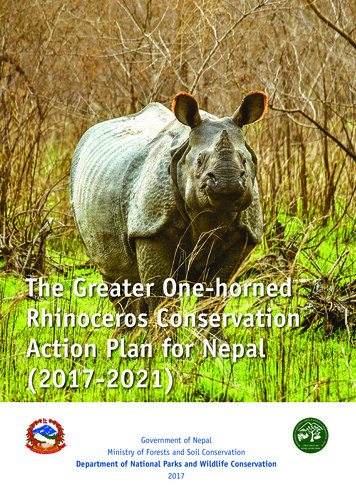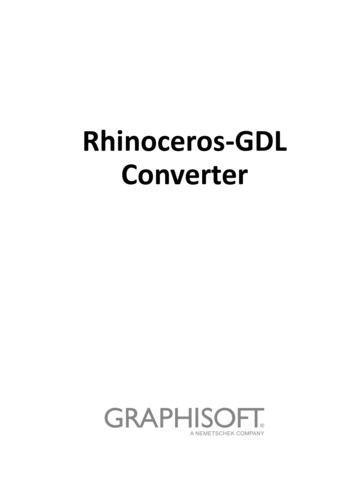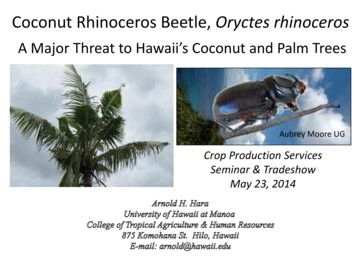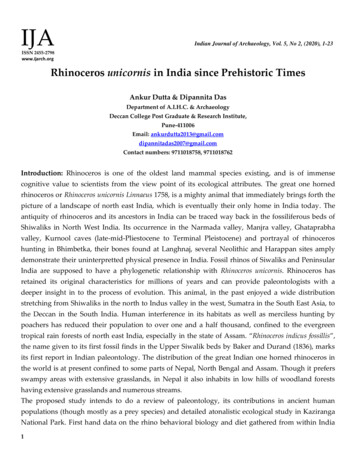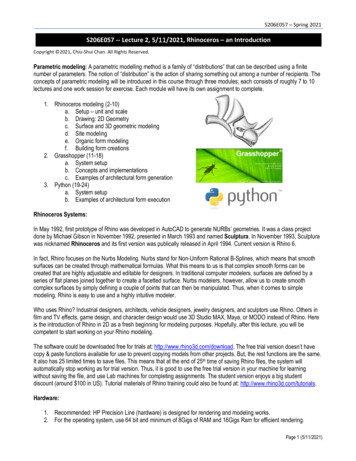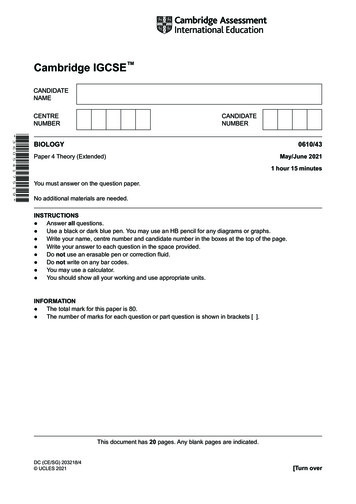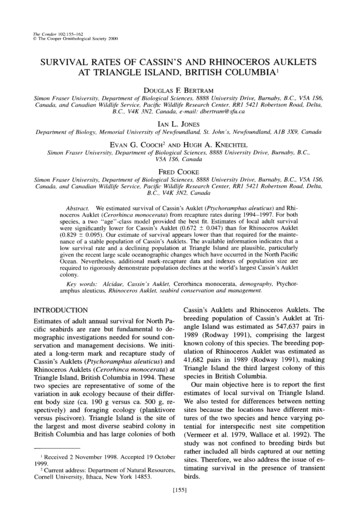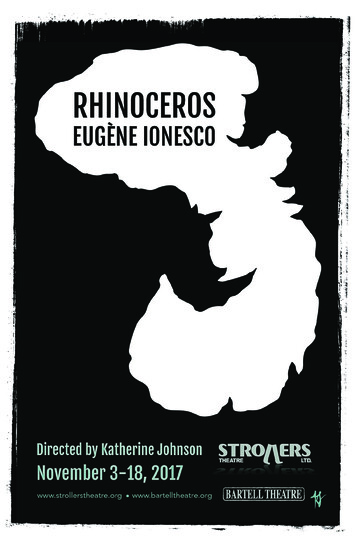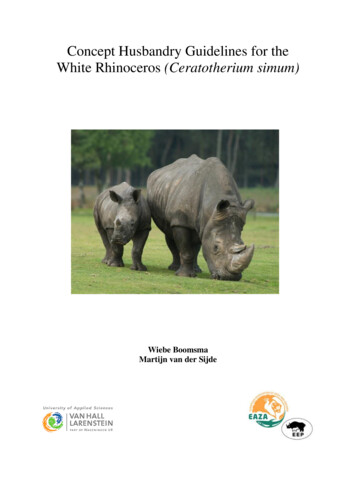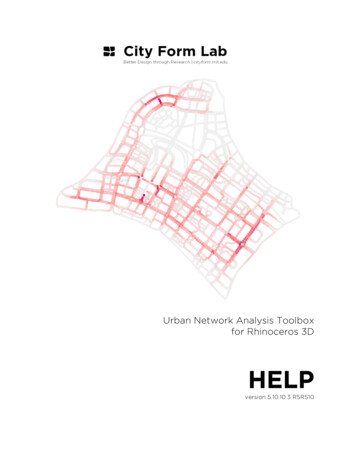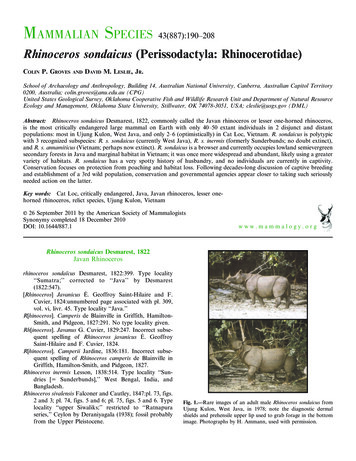
Transcription
MAMMALIAN SPECIES43(887):190–208Rhinoceros sondaicus (Perissodactyla: Rhinocerotidae)COLIN P. GROVESANDDAVID M. LESLIE, JR.School of Archaeology and Anthropology, Building 14, Australian National University, Canberra, Australian Capitol Territory0200, Australia; colin.groves@anu.edu.au (CPG)United States Geological Survey, Oklahoma Cooperative Fish and Wildlife Research Unit and Department of Natural ResourceEcology and Management, Oklahoma State University, Stillwater, OK 74078-3051, USA; cleslie@usgs.gov (DML)Abstract: Rhinoceros sondaicus Desmarest, 1822, commonly called the Javan rhinoceros or lesser one-horned rhinoceros,is the most critically endangered large mammal on Earth with only 40–50 extant individuals in 2 disjunct and distantpopulations: most in Ujung Kulon, West Java, and only 2–6 (optimistically) in Cat Loc, Vietnam. R. sondaicus is polytypicwith 3 recognized subspecies: R. s. sondaicus (currently West Java), R. s. inermis (formerly Sunderbunds; no doubt extinct),and R. s. annamiticus (Vietnam; perhaps now extinct). R. sondaicus is a browser and currently occupies lowland semievergreensecondary forests in Java and marginal habitat in Vietnam; it was once more widespread and abundant, likely using a greatervariety of habitats. R. sondaicus has a very spotty history of husbandry, and no individuals are currently in captivity.Conservation focuses on protection from poaching and habitat loss. Following decades-long discussion of captive breedingand establishment of a 3rd wild population, conservation and governmental agencies appear closer to taking such seriouslyneeded action on the latter.Key words: Cat Loc, critically endangered, Java, Javan rhinoceros, lesser onehorned rhinoceros, relict species, Ujung Kulon, VietnamE 26 September 2011 by the American Society of MammalogistsSynonymy completed 18 December 2010DOI: 10.1644/887.1www.mammalogy.orgRhinoceros sondaicus Desmarest, 1822Javan Rhinocerosrhinoceros sondaı̈cus Desmarest, 1822:399. Type locality‘‘Sumatra;’’ corrected to ‘‘Java’’ by Desmarest(1822:547).[Rhinoceros] Javanicus É. Geoffroy Saint-Hilaire and F.Cuvier, 1824:unnumbered page associated with pl. 309,vol. vi, livr. 45. Type locality ‘‘Java.’’R[hinoceros]. Camperis de Blainville in Griffith, HamiltonSmith, and Pidgeon, 1827:291. No type locality given.Rh[inoceros]. Javanus G. Cuvier, 1829:247. Incorrect subsequent spelling of Rhinoceros javanicus É. GeoffroySaint-Hilaire and F. Cuvier, 1824.R[hinoceros]. Camperii Jardine, 1836:181. Incorrect subsequent spelling of Rhinoceros camperis de Blainville inGriffith, Hamilton-Smith, and Pidgeon, 1827.Rhinoceros inermis Lesson, 1838:514. Type locality ‘‘Sundries [5 Sunderbunds],’’ West Bengal, India, andBangladesh.Rhinoceros sivalensis Falconer and Cautley, 1847:pl. 73, figs.2 and 3; pl. 74, figs. 5 and 6; pl. 75, figs. 5 and 6. Typelocality ‘‘upper Siwaliks;’’ restricted to ‘‘Ratnapuraseries,’’ Ceylon by Deraniyagala (1938); fossil probablyfrom the Upper Pleistocene.Fig. 1.—Rare images of an adult male Rhinoceros sondaicus fromUjung Kulon, West Java, in 1978; note the diagnostic dermalshields and prehensile upper lip used to grab forage in the bottomimage. Photographs by H. Ammann, used with permission.
43(887)—Rhinoceros sondaicusMAMMALIAN SPECIESRhinoceros nasalis Gray, 1868:1012. Type locality ‘‘Borneo.’’Rhinoceros floweri Gray, 1868:1015. Type locality ‘‘Sumatra.’’Rh[inoceros]. frontalis von Martens, 1876:257. Type locality‘‘Borneo.’’Rhinoceros karnuliensis Lydekker, 1886b:120, 121. Typelocality ‘‘Karnul caves,’’ Karnul District, Madras, India;fossil from the late Pleistocene.Rhinoceros karnuliensish Lydekker, 1886b:121. Incorrect subsequent spelling of Rhinoceros karnuliensis Lydekker, 1886b.R[hinoceros]. annamiticus Heude, 1892:113, pl. XIXA, figs. 1and 4. No type locality given; restricted to ‘‘Vietnam’’ byGroves and Guérin (1980:199).Rhinoceros sivasondaicus Dubois, 1908:1245, 1258. Typelocality ‘‘Kendeng [5 Solo Valley],’’ Java; fossil probably from the Upper Pleistocene.Rhinoceros [(Rhinoceros)] sondaicus: Lydekker, 1916:48.Name combination.Aceratherium boschi von Koenigswald, 1933:121. Typelocality ‘‘Java;’’ fossil from the late Pliocene (5Rhinoceros sondaicus fide Aimi and Sudijono 1979).Rhinoceros sinhaleyus sinhaleyus Deraniyagala, 1938:234,235, fig. 2. Type locality ‘‘Ratnapura series,’’ Sri Lanka;fossil probably from the Upper Pleistocene.R[hinoceros]. Javanensis Barnard, 1932:185. Incorrect subsequent spelling of Rhinoceros javanicus É. GeoffroySaint-Hilaire and F. Cuvier, 1824.Rhinoceros sondaicus simplisinus Deraniyagala, 1946:162, fig.2, pl. XXI. Type locality ‘‘Pothu kola Deniya, Nivitigala, near a tributary of the Hangamu ganga,’’ SriLanka; fossil probably from the middle Pleistocene.R[hinoceros]. s[ondaicus]. floweri: Groves, 1967:234. Namecombination.R[hinoceros]. s[ondaicus]. inermis: Groves, 1967:234. Namecombination.E[urhinoceros]. sondaicus: Heissig, 1972:29. Name combination.Rhinoceros sondaicus guthi Guérin in Beden and Guérin,1973:19. Type locality ‘‘Phnom Loang (Province deKampot, Cambodge [5 Cambodia]);’’ fossil probablyfrom the Pleistocene (Groves and Guérin 1980).Rhinoceros sondaicus annamiticus: Groves and Guérin,1980:199. Name combination.Rhinoceros son daicus annamiticus Poleti, Van Mui, Dang,Manh, and Baltzer, 1999:34. Incorrect subsequentspelling of Rhinoceros sondaicus Desmarest, 1822.CONTEXT AND CONTENT. Order Perissodactyla, suborderCeratomorpha, family Rhinocerotidae, subfamily Rhinocerotinae, tribe Rhinocerotini, genus Rhinoceros. The specifictype locality of R. sondaicus in Java is unknown (Rookmaaker 1982). The genus includes 2 species: R. sondaicus (Fig. 1)and R. unicornis (Indian rhinoceros—Grubb 2005). Morphologic data (Groves 1967, 1993, 1995a; Groves andChakraborty 1983; Groves and Guérin 1980; Grubb 2005)and haplotypic uniqueness (Fernando et al. 2006) have been191used to distinguish subspecies of R. sondaicus. At the specificlevel, for example, mean antorbital width and ratio of thewidth to height of occiput are 204.0 mm and 175.6 mm:subspecifically, R. s. annamiticus, 217.7 and 181.0; R. s.inermis, 198.8 and 165.0; and R. s. sondaicus, 187.3 (Java)and 188.8 (Sumatra) and 186.0 (Java), 176.0 (Sumatra), and171.0 (Malaya—Groves 1967, 1995a; Groves and Guérin1980). R. s. inermis (Sunderbunds and Malaya) is no doubtextinct. R. s. sondaicus (West Java) and R. s. annamiticus(southern Vietnam and Cambodia) are extremely rare intheir extant range (limited to 2 localities—Amin et al. 2006;Talukdar et al. 2009; van Strien et al. 2008) and extinct in allformer ranges, making collection of additional specimensimpossible; further assessments of materials in privatecollections and provincial museums are needed to clarifysubspecific designations. Grubb (2005) recognized thefollowing 3 subspecies:R. s. annamiticus Heude, 1892. See above.R. s. inermis Lesson, 1838. See above.R. s. sondaicus Desmarest, 1822. See above.NOMENCLATURAL AND HISTORICAL NOTES. Along withskins and skeletal material, live wild animals were capturedand shipped from all over the world in the 1700s and 1800s(e.g., Brandon-Jones 1997; Elliot and Thacker 1911), manyto European menageries—some traveling and some stationary (Hoage et al. 1996). Rhinoceroses were particularlyprized, and the Zoological Gardens of the Royal ZoologicalSociety of London, established in 1828, paid 800 (U.S.equivalent today 5 77,800) for a R. sondaicus in 1874 and 1,000 ( 116,900) for a R. unicornis in 1834 (Sclater 1874,1876b). An interesting case that affected the nomenclaturalhistory of R. sondaicus was the ‘‘Javan Rhino in the BerlinZoo’’ that also passed through the Zoological Gardens inLondon (Reynolds 1961; Sclater 1876b). William Jamrach,from a well-known family of ‘‘animal traders’’ in the mid1800s (Brandon-Jones 1997), brought a rhinoceros fromManipur, India, to London in 1874. Jamrach was unsatisfiedwith its taxonomic identification as R. sondaicus byzoologists in London (Reynolds 1961), so he named itRhinoceros jamrachii after himself in an unpublished reportwith no nomenclatural standing (Groves 1967; Sclater1876b). This rhinoceros was shipped to the Berlin Zoo in1874, and P. L. Sclater identified it there in 1879 as R.unicornis (Reynolds 1961). Groves (1967:234) included R.jamrachii Sclater, 1876b, as a questionable synonym of R.sondaicus inermis, but Grubb (2005:636) listed R. jamrachiJamrach, 1875, as a synonym of R. unicornis. Unfortunately,the specimen and its records were lost to World War II, andbecause it was never definitively identified as R. sondaicus(Reynolds 1961; Rookmaaker 1980, 1998), we did notinclude the name jamrachii in our synonymy. Anothercaptive specimen, called the ‘‘Liverpool Rhinoceros,’’ experienced a similar identity crisis from the 1830s (Reynolds
192MAMMALIAN SPECIES1960) until Rookmaaker (1993) concluded it was R. unicornisnot R. sondaicus.Our early perceptions of general characters of R.sondaicus had a curious evolution in science and art (Clarke1986; Cole 1953; Rookmaaker and Visser 1982). As early asRoman times (Cole 1953), rhinoceroses were imported andheld captive in Europe (Rookmaaker 1998). In 1515, theshipment of an Indian rhinoceros to Lisbon, Portugal,caused much ado throughout the continent, although it diedin a shipwreck a year later on route to Italy as a gift to PopeLeo X (Clarke 1986); the animal was stuffed and presentedto the Pope (Cole 1953). Based on sketches by others, thefamous German artist Albrecht Dürer (1471–1528), whoalso designed armor, produced the still-familiar woodcut ofthe armored ‘‘Lisbon rhino’’ (Fig. 2a). More than 150 yearslater, a woodcut of the ‘‘Rhinocerote’’ of Java (Fig. 2b)appeared in Jacobus Bontius’ tome on the animals of Java(1658, published posthumously). Bontius (1596–1631) was aphysician and naturalist and best known for his discovery ofberiberi in Asia, later determined to be caused by a vitaminB1 deficiency. He died 27 years before the publication of hisnatural history work in Java (Bontius 1658), and the editor,G. Piso, added the illustration shown here in Fig. 2b(Rookmaaker and Visser 1982). The similarity betweenDürer’s illustration, clearly of a stylized Indian rhinoceros,and that in Bontius (1658) is striking (Clarke 1986),particularly the shape of the dermal shields, horn, andposture. Nevertheless, the Bontius illustration is lessarmored looking than Dürer’s and depicts a nape shieldtypical of R. sondaicus (Rookmaaker and Viser 1982) and, inour opinion, the extended upper lip, ears, visible tail in sideprofile, and epidermal patterning are more like the realisticearly illustration of R. sondaicus in Horsfield (1824; Fig. 2c).The evolution from the novelty of Dürer’s woodcut to therealism of Horsfield’s illustration took almost 3 centuries(Clarke 1986; Cole 1953).The generic epithet Rhinoceros means nose (rhino)-horn(ceros) in Greek, and the specific epithet sondaicus referencesthe Sunda Islands (5 Java) with the Latin locality suffix‘‘icus.’’ Along with Javan rhinoceros (rhino), other commonnames include lesser Indian rhinoceros (19th century—Rookmaaker 2006); lesser one-horned rhinoceros; warak(Javanese); baduk or badak (Malay and Sundanese [westernparts of Java]); gomda, ganda, genda, gainda, gomela, andgainra (Hindi); gonda (Bengali); kunda, kedi, and kweda(Naga); kyeng and kyan-tsheng, kyan-hsin or pyan-hsin, andmeeza (Burmese); rhinoceros de la Sonde (French); andrinoceronte de Java (Spanish—Cole 1953; Evans 1905;Horsfield 1824; Lydekker 1907; U Tun Yin 1967; van Strienet al. 2008). More descriptive Malayan names include badakbersisih (5 scaly rhinoceros) and badak tenggiling (5pangolin rhinoceros—Miller 1942). The 100th anniversaryof the Museum Zoologicum Bogoriense (Java) was commemorated with a 700-rupiah stamp featuring R. sondaicus43(887)—Rhinoceros sondaicusFig. 2.—Early renditions of rhinoceroses involving our perceptionof Rhinoceros sondaicus: a, 16th century woodcut by German artistAlbrecht Dürer of an Indian rhinoceros (R. unicornis) imported toPortugal in 1515; b, R. sondaicus from Java as depicted in Bontius(1658); and c, R. sondaicus from Java in Horsfield (1824), the mostrealistic of the 3 illustrations (if the electronic image is enlarged, theclosely arranged epidermal polygons and nape shield are evident inpanel c).
43(887)—Rhinoceros sondaicusMAMMALIAN SPECIES(Foose and van Strien 1995). In the late 1970s, theIndonesian 100-rupiah note carried the image of R.sondaicus.DIAGNOSISRhinoceros sondaicus is similar but generally smaller(Anonymous 1874; Blyth 1875; Lydekker 1907; Sclater 1874)than the Indian rhinoceros (Dinerstein 2011; Laurie et al.1983). The skull of R. sondaicus is lighter than that of theIndian rhinoceros. In R. sondaicus, basal length of the skullis , 600 mm; maxillary toothrow length is , 241 mm; nasalsare comparatively smooth, pointed, and rarely . 110 mmwide; and occiput from opisthion to inion is , 190 mm. Incontrast to the Indian rhinoceros, premaxillae in R.sondaicus are narrow and (except in aged individuals)unfused to the maxillae and freely movable on them, andthe vomer is thin and free from pterygoids except in very oldindividuals. Cheek teeth are not strongly hypsodont; crownheights of unworn M1–2 are 46–53 mm; parastyle buttress ispronounced; ectoloph is sinuous; crista is rudimentary orabsent; protocone fold is absent; and at least a remnant oflingual cingulum is present on upper cheek teeth.Skin folds are shallower on R. sondaicus than on the Indianrhinoceros (Anonymous 1874; Blyth 1875; Lydekker 1907);subcaudal folds fall short of the pelvis; posterior cervical foldsfollow a rounded, posterodorsal direction to meet behind thewithers; and epidermal polygons are close and flattened, givingthe skin a reticulated appearance. The form of the posteriorcervical fold (lateral shoulder fold) in R. sondaicus, continuingup over the nape of the neck forming an independent shieldshaped like a saddle, is diagnostic; in the Indian rhinoceros, thenape shield is continuous with the larger shoulder shield(Sclater 1874, 1876b:plates XCV and XCVI). Mature males donot develop the enlarged ‘‘bib’’ and deep cheek and neck foldsof the Indian rhinoceros, at least not to the same degree. Thetail of R. sondaicus stands out distinctly from the hindquarters,‘‘so that its whole extent is exposed in a side view’’ (Lydekker1907:25). In contrast to the Indian rhinoceros, intestinal villi ofR. sondaicus are shorter and broader, and the caecum andcolon are shorter (Beddard and Treves 1887).GENERAL CHARACTERSThe genus Rhinoceros is distinguished by a single nasalhorn; both upper and lower incisors are present, the laterallower incisors being hypertrophied and tusklike; deciduousdentition has DM1; cheek teeth are subhypsodont; medisinus of upper molars is of approximately equal depth topostsinus; and crochet of upper molars arises from apex ofmetaloph (Groves 1982b). The skull is short (Carter and Hill1942; Peters 1878:tafeln 1–3), with the occipital planeinclined forward making the dorsal profile strongly concave;193postglenoid and posttympanic are fused below auditorymeatus; orbitoaural length is greater than orbitonasal;infraorbital foramen is above P2; posterior edge of nasalnotch is over P1 position; and auditory meatus is closedinferiorly by fusion of the post-glenoid and post-tympanicprocesses. The lacrimal bridge is usually ligamentous, andthe antorbital process is ovate (Cave 1965). The skull of R.sondaicus relative to that of the Indian rhinoceros hasunexpanded nasal bones not forming a nasal boss, lessdeepened dorsal concavity, premaxillae free from maxillaeuntil old age, and a thin vomer free (until old age) frompterygoids. The maxillary molar and premolar teeth retaintheir p-like shape, unlike the Indian rhinoceros, and thebuccal margins (ectolophs) are markedly sinuous, withprominent styles. Skin folds including scapular, pelvic,humeral, femoral, and subcaudal are pronounced (Figs. 1and 2c). Processus glandis of the penis is located on eitherside of the dorsum of the glans, with a relatively long sessileanteroposterior attachment to glans and long narrowprojection laterally (Cave 1965).Few measurements of mass of R. sondaicus are available; 1female, 1,500 kg; 1 male, 1,200 kg (Groves 1982a), and 1exceptional specimen, said to be 2,280 kg (Sody 1959). Headand-body lengths ‘‘over curves’’ are 305–344 cm, and shoulderheights are 120–170 cm, slightly higher at the rump than at thewithers (Groves 1982a). Females may be slightly larger thanmales (Groves 1982a; Hoogerwerf 1970), but definitiveconclusions are lacking (Groves 1995b). The nasal horn occurson males, rarely on females (Lydekker 1907 cf. Groves 1982a),and is slightly curved backward. Length of the horn averages20–25 cm (Groves 1982a) but may reach 30.5 cm straight and36.9 cm on the curve (Finlayson 1950); a record length fromBurma was shorter at 27.3 cm (Peacock 1933). The base of thehorn is about 12 by 18 cm and narrows to 5.5 by 7.5 cm at thesmooth part of the horn, beginning at about 8 cm abovethe base. The breadth of the stem is 40–50% of the breadth ofthe base, which shows fibrous ends in young R. sondaicus, but itbecomes smoother, but grooved, with a broad, deep anteriorlongitudinal groove (as in Indian rhinoceros) in adults.The color of the generally hairless hide of R. sondaicus istypically gray to dusky gray rather than brown (Lydekker1907); the horn is black. The epidermal mosaic-like polygonson the skin resemble scales (Harper 1945; Lydekker 1907;Peacock 1933) and are clearest on limbs and detectable fromsome distance. Body hair is visible in young, but it virtuallydisappears in adults except for ear-fringes, eyelashes, and atail-brush. Pedal scent glands are present, as in the Indianrhinoceros (Beddard and Treves 1887). The upper lip is longand flexible (almost prehensile).DISTRIBUTIONRhinoceros sondaicus is now apparently restricted to 2localities (Fig. 3): the extreme western end of the island of
194MAMMALIAN SPECIESFig. 3.—Rhinoceros sondaicus occurs in only 2 very small areas ofsoutheastern Asia: Ujung Kulon, West Java (about 6u459S,105u159E), and Cat Loc, Vietnam (about 11u359N, 107u229E;perhaps extinct). Green shading delimits areas of known historicaldistribution based on museum specimens collected beginning in themid-1800s (Groves 1967; Rookmaaker 1980).Java in Ujung Kulon National Park (Murphy 2004; WorldConservation Monitoring Centre 2005) and Cat Loc in CatTien National Park in southern Vietnam (Santiapillai 1992;Schaller et al. 1990), if not now extinct in this latter locality.It once ranged throughout much of the central Indochinesesubregion and the southwestern Sondaic subregion ofsoutheastern Asia (Corbet and Hill 1992:map 106). Becauseof the critically endangered status of R. sondaicus, its generalhistorical distribution and decline have been summarizedrepeatedly (e.g., Groves 1967; Harper 1945; Hoogerwerf1970; Loch 1937; Rookmaaker 1980; Sody 1959). Lackingdefinitive records, we consider that generalized historicaldistribution of R. sondaicus (e.g., Foose and van Strien 1997;van Strien et al. 2008) to be overstated.In Java, R. sondaicus was much more widespread andascended volcanic mountains up to 3,300 m above mean sealevel (Horsfield 1824; Sody 1959), but it is now isolated inthe western coastal lowlands (Hoogerwerf 1970). Even inUjung Kulon, a lowland rain forest, Ammann (1985) foundthat low-lying areas are used more than higher ground. In43(887)—Rhinoceros sondaicusSumatra, the last known individuals were killed between1927 and 1933 (de Beaufort 1928; Hazewinkel 1933; Sody1959; Vageler 1927). R. sondaicus was never known to occurin Borneo in recent times, but fossils from the latePleistocene–early Holocene have been found (Cranbrook1986), and some evidence suggests they may have survivedthere until the 10th century, perhaps longer (Cranbrook andPiper 2007). R. sondaicus was very uncommon or extinct inMalaya by the 1930s (Comyn-Platt 1937; Fetherstonhaugh1951; Page 1934); the last known individual was shot inKroh Forest, Perak, in 1932. Prior to that time, it was notfound east of the north–south mountain range that dividesthe Malay Peninsula (Harper 1945), and it was extinct in theTelok Anson District where it had once occurred (Morris1935). The supposed rediscovery of R. sondaicus in Malayain the 1950s (Ali and Santapau 1958) was based on aphotograph of a Sumatran rhinoceros (Dicerorhinus sumatrensis—Groves and Kurt 1972) with an extremely small 2ndhorn.In Thailand, Loch (1937) gives Krabin as a formerlocality of R. sondaicus. In the 1970s, it was still reported bylocal villagers in the Tenasserim Range of southwesternThailand (McNeely and Cronin 1972; McNeely and Laurie1977). In Burma (5 Myanmar), R. sondaicus was common inthe mid-1800s (Mason 1882), uncommon by the end of thecentury (Evans 1905), and very uncommon by the 1920s(Ansell 1947; Blanford 1939); 6 individuals were said to existin the Kahilu Game Sanctuary in the 1930s (Thom 1935); atleast 2 R. sondaicus were consistently reported on theThaton–Pegu border from 1939 to 1949; 1 individual wasshot on the Tavoy–Amherst border in 1954 (U Tun Yin1954, 1956); and 2 individuals possibly occurred in theTavoy region on the Burma–Thailand border in 1958–1962(McNeely and Cronin 1972; Milton and Estes 1963). Asingle individual was encountered by poachers near theBurma–Thailand border in 1958; a pregnant female waskilled there and another individual was encountered in 1960(McNeely and Cronin 1972); a few individuals may havesurvived after that in the northern sector of the TenasserimYoma within Kawthulei State and Moulmein (formerlyAmherst) District (U Tun Yin 1967). According to Peacock(1933), R. sondaicus never occurred outside of the formerThaton, Salween, and Mergui forest divisions of Burma (5peninsular parts of Burma), where it inhabited heavyevergreen forests on relatively flat ground (Groves 1967).Rhinoceros sondaicus was well known in Laos andCambodia (Flower 1900; Harper 1945; Rookmaaker 1980).Although Rookmaaker (1988) thought that a few individuals may occur there, none have been found recently (Daltryand Momberg 2000; Talukdar et al. 2009). In Cambodia, itis depicted on bas-reliefs at Angkor Wat (de Iongh et al.2005), and the last known individual was shot on the ChupPlateau, Kampong Cham Province, in May 1930 (Poole andDuckworth 2005). In Vietnam and Laos, it may have
43(887)—Rhinoceros sondaicusMAMMALIAN SPECIESoccurred up to the Chinese border, but definitive specimensare lacking (Rookmaaker 1980:figure 2). Over much of thisarea, the Indian rhinoceros is the only rhinoceros speciessaid to have occurred there, but R. sondaicus is known fromCochin China in southern Vietnam (Groves 1967; Harper1945; Rookmaaker 1980).Rhinoceros sondaicus is the only rhinoceros known tohave occurred in the Sunderbunds of India and Bangladesh(Rookmaaker 1980, 1997, 2006). Its presence there wasconfirmed up until the late 1800s (Burton 1951). In January–February 1892, de Poncins (1935) estimated that 3 or 4individuals probably existed on 5 islands; he saw 1 individualbut refused to kill it. Harper (1945) mentioned theoccurrence of R. sondaicus in Orissa, the Mahanadi delta,and the Jalpaiguri forest. Higgins (1935) suggested that R.sondaicus occurred in the Manipur Hills in the early 1930s,but he could not corroborate that with personal observations. Given that the identity of a captive specimen from theManipur Hills in 1874, initially referred to as R. sondaicusand then as an Indian rhinoceros, is in doubt (Reynolds1961), the presence of the former species there remainsunproven. It did, however, occur at Moraghat, in theJalpaiguri district of northern West Bengal, as verified by 1female specimen in the Copenhagen Museum (Rookmaaker2006); here, it was apparently sympatric with the Indianrhinoceros, of which there also is a skull from the samelocality, now in Copenhagen.FOSSIL RECORDThe evolution of rhinoceroses spans 50 million years, andfossil evidence of 60 genera and hundreds of species exist—forms that ‘‘occupied nearly every niche available to largemammalian herbivores’’ (Cerdeño 1995; Dinerstein 2003,2011; Prothero 1993:82; Prothero et al. 1986). Rhinocerotoidsdominated large land mammalian faunas from 34 millionyears ago until the ‘‘mastodonts escaped from Africa about 18million years ago’’ (Prothero 1993:82). The common ancestorof extant species of rhinoceroses may date from 28 to 33million years ago with the next divergence within the groupoccurring only 1.0–1.5 million years later (Willerslev et al.2009 cf. Tougard et al. 2001).According to Hooijer (1949:126), R. sondaicus changed‘‘from a swift-moving to a slow-moving animal during theQuaternary’’ but not as evolved as the Indian rhinoceros(Hooijer 1946a). Fossil remains of R. sondaicus from the earlyand middle Pleistocene have been found in Java (Sangiran,Ngandong, and other sites—Hooijer 1964), middle Pleistocene from Malaya (Hooijer 1962a), middle Pleistocene fromnorthern Vietnam (Bacon et al. 2004), and probablePleistocene from Cambodia (Beden and Guérin 1973). TheJavanese fossil race was less graviportal with longer distallimb segments than extant R. sondaicus (Hooijer 1949).Subfossil remains are known from Sumatra (Hooijer 1948),195Borneo (Cranbrook 1986; Cranbrook and Piper 2007),Malaya (Hooijer 1962b), and Java (Dammerman 1934).During the Pleistocene, R. sondaicus, or precursors, occurredin India and Sri Lanka (Chauhan 2008; Deraniyagala 1937,1938, 1946; Lydekker 1877, 1886a, 1886b; ManamendraArachchi et al. 2005), well beyond its current distribution(Fig. 2). Hooijer (1946b) concluded that R. karnuliensis wassimilar to R. sondaicus. R. sinhaleyus (5 R. sondaicussimplisinus) also was probably conspecific, although no doubtsubspecifically distinct. Neolithic remains have been described from Cambodia (Guérin and Mourer 1969).FORM AND FUNCTIONRelatively few museum specimens of Rhinoceros sondaicus exist for comparisons (Barbour and Allen 1932; Loch1937). Groves (1967:tables 4 and 5) provided various skulland teeth measurements of recent specimens by country oforigin and comparisons with Pleistocene and subfossilspecimens. Although sample size was relatively small,representative mean basal skull lengths (mm 6 SD) were:Java, 575.8 6 14.1 (n 5 9); Sumatra, 578.4 6 14.3 (5);Malaya, 506.5 6 10.6 (2); Vietnam, 525.0 6 2.8 (2); andBengal, 567.3 6 17.5 (3).In contrast to other genera of rhinoceroses (Groves1971), the base of the horn in Rhinoceros rises rapidly, inontogeny, above dorsum nasi, with a broad, irregularlygrooved basal zone; the original tubercular knob becomessmooth as the epidermal polygons fuse together withcontinuous keratinization; a specimen is known with ascaleless epidermal field several centimeters behind the horn,possibly representing an incipient frontal horn (Neuville1927). The horn is said to be totally lacking in female R.sondaicus from the Sunderbunds (de Poncins 1935; Fraser1875; Sclater 1876a) and probably Sumatra (Vageler 1927),but in some populations, it occurs in females as a smalltuberosity (Ammann 1985; Barbour and Allen 1932;Neuville 1927; Schuhmacher 1967). One female skull fromTenasserim in the Natural History Museum (London),specimen 1921.5.15.1, has a horn 19.2 cm long.Rhinoceros sondaicus is generally said to be hairless,although a sparse hairy covering has been noted (Cave 1969;Groves 1967); the female specimen from Tenasserim mentioned above is decidedly hairy. Hairs are probably abradedand lost with age, as is the case with other rhinoceros species.Another specimen in the Natural History Museum (London)(1932.10.21.1) lacks visible hair, and because it was superblymounted, loss of any hair during mounting seems unlikely.Epidermal polygons are flat and closely arranged, so thatparts of the hide appear divided by a network of cracks(Fig. 2c). Skin thicknesses of R. sondaicus vary from 2.5 to3.5 cm depending on the location on the body (Sody 1959).Using an age-based sequence of the increasing 3-toedfootprint size of Indian rhinoceroses in the Basel Zoo,
196MAMMALIAN SPECIESSwitzerland, Hoogerwerf (1970) developed a system todifferentiate sexes and young of R. sondaicus in UjungKulon. That classification provided insight into productivityand sex ratios and has been followed by others (e.g., Poletiet al. 1999; Sadjudin 1987; Santiapillai et al. 1993a, 1993b;Schenkel and Schenkel-Hulliger 1969a). Forefoot printsof adult R. sondaicus are up to 32 cm wide (Hoogerwerf1970), which is as large as the Indian rhinoceros. Toes(5 hooves) are less prominent and soles are more extensivethan in the Sumatran rhinoceros (van Strien 1978). Despitethe purported greater size of female than male R. sondaicus,footprints of males are larger than those of females,which were never . 28 cm (Hoogerwerf 1970). Ammann(1985) gives the following forefoot widths: adult males, 26–29 cm (n 5 5); adult females, 25–27.5 cm (7); and immature,, 24 cm.The premaxillae have long, slender, preincisive processes(Fig. 4); they fuse with the maxillae late in life or not at all;I1s are lost in old age (Pocock 1944). A partially ossifiednasal septum occurs, particularly in museum specimens ofR. s. inermis from the Sunderbunds (Fraser 1875; Pocock1945a). The skull of R. sondaicus is small and lighter thanthat of the Indian rhinoceros (Laurie et al. 1983); there is lessnasal expansion, and the horn base is generally pointedrather than rounded; the ascending ramus is less elongated;the occiput is comparatively low and broad, giving ashallower dorsal profile to the skull as a whole; the posteriormargin of the palate has a pronounced median projection;the basilar region is broad; the pterygoids usually are morelaterally expanded; and the vomer is thin and free from thepterygoids, except in old age when they may fuse with thefloor of mesopterygoid fossa (Colbert 1942; Pocock 1945b).The lacrimal bridge remains ligamentous in
bersisih (5 scaly rhinoceros) and badak tenggiling (5 pangolin rhinoceros—Miller 1942). The 100th anniversary of the Museum Zoologicum Bogoriense (Java) was com-memorated with a 700-rupiah stamp featuring R. sondaicus Fig. 2.—Early renditions of rhinoceroses involving our perception of Rhinoceros
